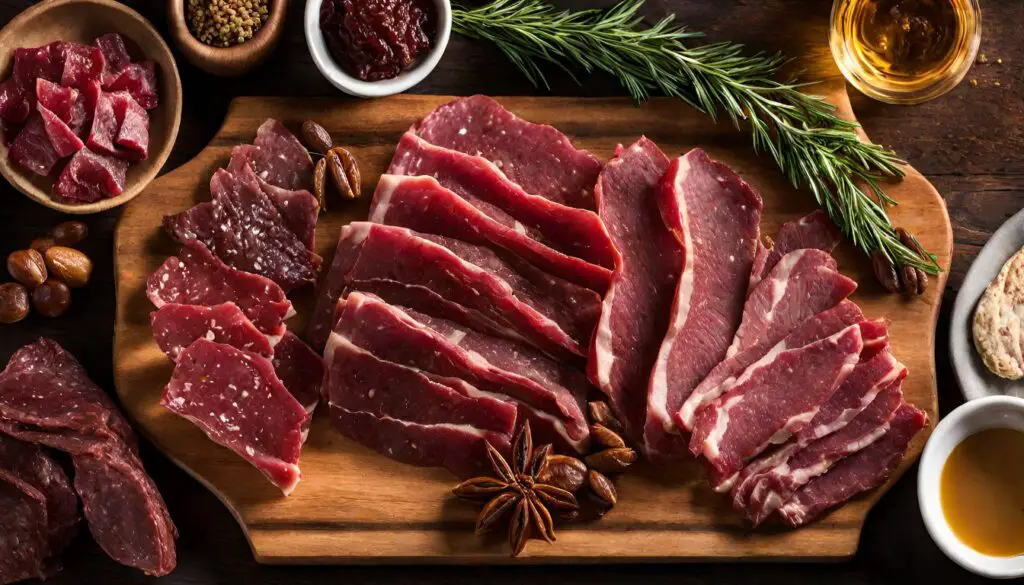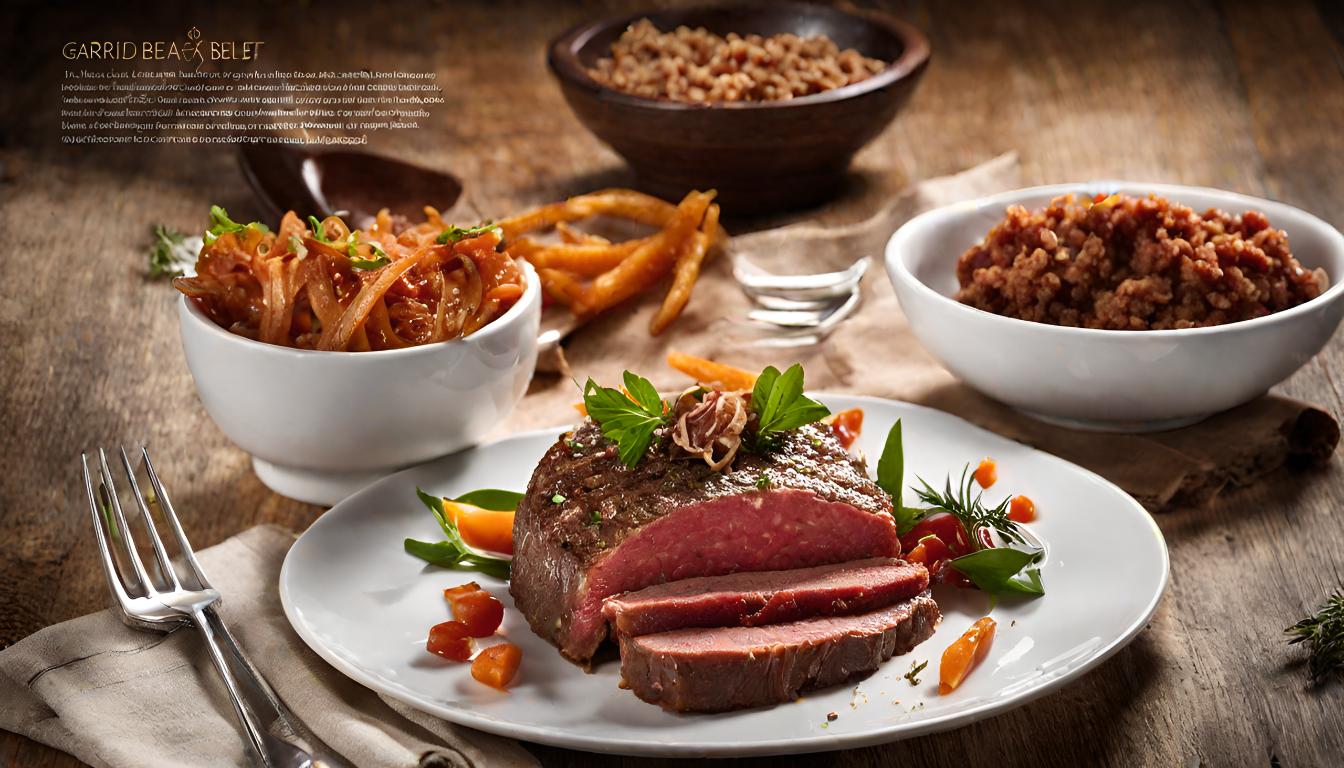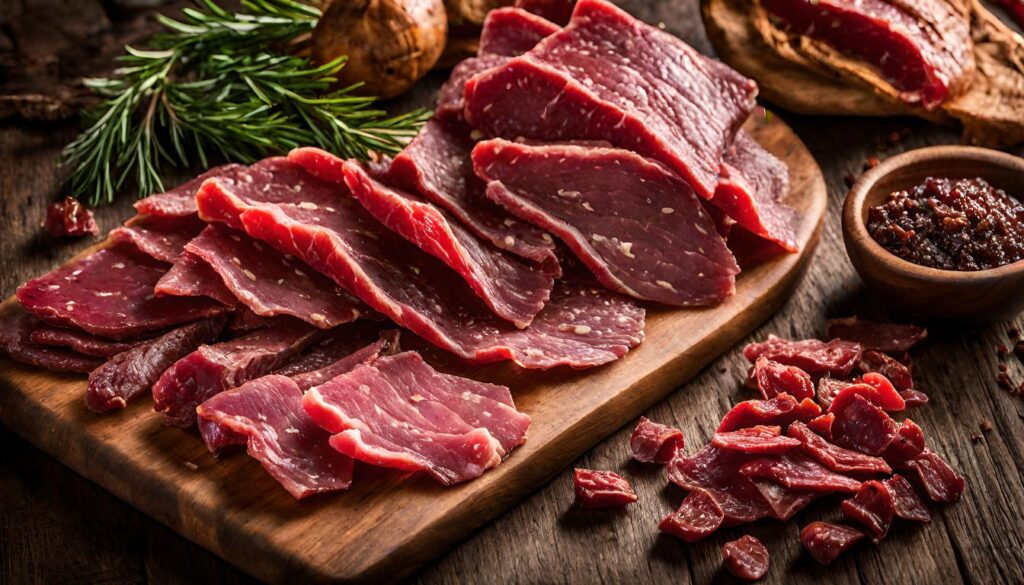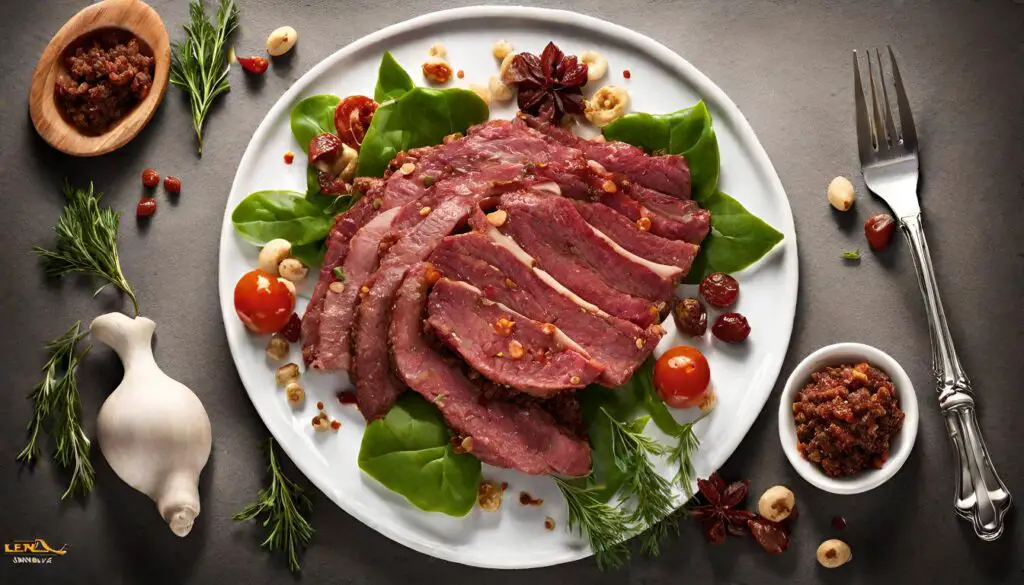Definition and History
Dried beef, often known as jerky, is beef that has been trimmed of fat, cut into strips, and then dried to prevent spoilage. This process dates back to ancient times, used by indigenous peoples and early civilizations as a means to preserve meat for long periods. The term “jerky” itself is derived from the Quechua word ch’arki, meaning “dried, salted meat.” This age-old practice has traversed continents and cultures, making dried beef a global phenomenon.
Popularity and Cultural Significance
The popularity of dried beef spans across the globe, from the Biltong of South Africa to the Cecina of Spain. Each region has its unique take on this dehydrated delicacy, often influenced by local flavors and available spices. In the United States, beef jerky is a popular snack, known for its rich, smoky flavor and chewy texture. It’s not just a snack, though; dried beef plays a significant role in survival situations, thanks to its long shelf life and high nutrient content.
Part 2: Different Types of Dried Beef Around the World
Dried beef, in its many forms, showcases a rich tapestry of culinary traditions from around the globe. Each type offers a unique flavor and texture, influenced by local ingredients and preservation methods.
Traditional Dried Beef Varieties
One of the most renowned varieties is Biltong, a South African specialty. Unlike its American counterpart, biltong is often made from various types of meat and flavored with vinegar, salt, and spices before drying. It’s thicker than typical jerky and has a distinctively tangy flavor.
In Europe, particularly in Spain, Cecina is a popular form of dried beef. It’s similar to ham but made from beef, cured with salt and air-dried for months. This process imparts a deep, rich flavor and a tender texture that’s highly prized in Spanish cuisine.
Modern Innovations in Dried Beef
In recent years, there’s been a surge in innovative takes on dried beef. Gourmet versions with exotic flavors like teriyaki, chipotle, and even coffee-infused jerky have emerged. These modern twists cater to a broader palate, combining traditional drying techniques with contemporary flavors.
Discover traditional food preservation methods:
National Center for Home Food Preservation
The diversity of dried beef is a testament to its versatility and enduring popularity. From the plains of Africa to the bustling cities of America, It continues to be a beloved snack and ingredient.
Part 3: Nutritional Benefits
Dried beef is not only a flavorful snack but also a nutritional powerhouse. Its profile is rich in essential nutrients, making it a beneficial addition to various diets.
Macronutrients and Calories
Dried beef is predominantly known for its high protein content, essential for muscle building and repair. A single ounce of beef jerky can contain about 9 grams of protein. It’s also low in carbohydrates, making it an ideal snack for those on low-carb or ketogenic diets.
While it’s a protein-rich food, dried beef can be high in sodium and, depending on the preparation, in saturated fat. However, many producers now offer lower-sodium and leaner options, making it easier to enjoy It as part of a balanced diet.

Vitamins and Minerals
In terms of micronutrients, dried beef is a significant source of iron, crucial for transporting oxygen in the blood. It’s also rich in zinc, which is vital for immune function and wound healing. Additionally, dried beef provides B vitamins, particularly vitamin B12, essential for brain health and energy production.
Learn more about the nutritional benefits of beef:
Beef.org – Nutritional Information
Explore our Chicken Tenderloin Recipes for more protein-rich meal ideas:
Understanding the nutritional content of dried beef allows for its mindful inclusion in a diet, reaping the benefits of its rich nutrient profile while managing intake of sodium and fats.
Part 4: Culinary Applications of Dried Beef
Dried beef, with its unique flavor and texture, is a versatile ingredient that enhances a variety of culinary creations, from traditional dishes to contemporary cuisine.
Traditional Recipes Using Dried Beef
In traditional cooking, It often plays a starring role. A classic example is the American dish, Chipped Beef on Toast, where thin slices of dried beef are served in a creamy sauce over toast. This dish, also known as “S.O.S.” in military slang, is a comfort food staple with a rich history.
In South Africa, biltong is not just a snack but also an ingredient in various dishes. It’s often added to stews, quiches, and even baked goods, providing a savory, meaty flavor that complements a wide range of recipes.
Modern Cooking and Dried Beef
In modern cuisine, chefs are getting creative with dried beef. It’s used as a topping for salads and pizzas, adding a burst of umami flavor. Gourmet sandwiches and wraps also feature dried beef, paired with fresh vegetables and artisanal bread for a contemporary twist on classic flavors.
For a sweet treat after your savory meal, check out our Small Batch Chocolate Chip Cookies recipe:
Small Batch Chocolate Chip Cookies
The adaptability of dried beef in cooking makes it a beloved ingredient in both home kitchens and professional culinary settings. Its ability to add depth and richness to dishes is unmatched, making it a valuable component of any chef’s pantry.
Part 5: How Dried Beef is Made
The process of making It is a fascinating blend of tradition and technology. Understanding these methods provides insight into how this simple product achieves its complex flavors and textures.
Traditional Drying Techniques
Traditionally, making dried beef involves slicing the meat thinly, marinating it with salt and spices, and then drying it in the open air or with the aid of gentle heat. Sun-drying is one of the oldest methods, used in many cultures for centuries. This slow process allows for the development of rich flavors and a chewy texture. In some regions, smoking is also used to add a distinctive smoky flavor and to aid in preservation.
Industrial Production
In contrast, industrial production of dried beef uses controlled environments to ensure consistency and safety. The meat is still marinated and seasoned, but the drying process occurs in large dehydrators or ovens where temperature and humidity are carefully regulated. This method allows for faster production and a more uniform product. Advanced techniques like vacuum drying are also employed to create different textures and flavor profiles.
Whether made traditionally or industrially, the key to good dried beef lies in the quality of the meat and the precise balance of seasoning and drying. This process, honed over generations, is what makes It a unique and cherished food item worldwide
Looking for more hearty dishes? Check out our Delicious Gumbo Recipe for a taste of Southern comfort:
Delicious Gumbo Recipe: A Taste of Southern Comfort
Part 6: Buying and Storing
Selecting Quality Dried Beef
When purchasing It, look for products with a deep, rich color and a pleasing aroma. The meat should be dry but still pliable, not overly hard or brittle. Check the ingredient list for any additives or preservatives if you prefer a more natural product. Artisanal or locally produced dried beef often offers a higher quality with unique flavor profiles compared to mass-produced options.
Storage and Preservation
Proper storage is key to preserving the quality of dried beef. Unopened, it can be stored in a cool, dry place for several months. Once opened, it’s best to keep it in the refrigerator to maintain freshness. If you notice any signs of spoilage, such as off-odors or mold, it’s best to discard the product.
By choosing quality dried beef and storing it correctly, you can enjoy this delicious and nutritious snack at its best, whether you’re on the go or savoring it at home.

Part 7: Frequently Asked Questions
In this final section, we address some of the most common questions surrounding dried beef, offering insights to help you make informed decisions about incorporating this food into your diet.
Common Queries and Expert Answers
Q: How long does dried beef last?
A: Unopened dried beef can last several months when stored in a cool, dry place. Once opened, it’s best to consume it within a few weeks, especially if stored in the refrigerator.
Q: Is dried beef healthy?
A: It is a good source of protein and essential minerals like iron and zinc. However, it can be high in sodium and, in some cases, saturated fat. Moderation is key, and opting for leaner, lower-sodium varieties can make it a healthier choice.
Q: Can dried beef be used in cooking?
A: Absolutely! It can be a versatile ingredient in the kitchen. It’s great in sandwiches, salads, and even cooked dishes like stews and casseroles, where it adds a rich, savory flavor.
Find creative recipes :
Q: Are there any dietary concerns with dried beef?
A: Those on low-sodium diets or watching their cholesterol intake should consume it in moderation. Also, individuals with specific food allergies should check labels for potential allergens.
With these FAQs, we wrap up our comprehensive guide . From its rich history and varied types to its nutritional profile and culinary uses, dried beef is a fascinating and delicious food that has stood the test of time. Whether enjoyed as a snack or used as an ingredient in your favorite dish,it offers a unique combination of flavor, nutrition, and convenience.









